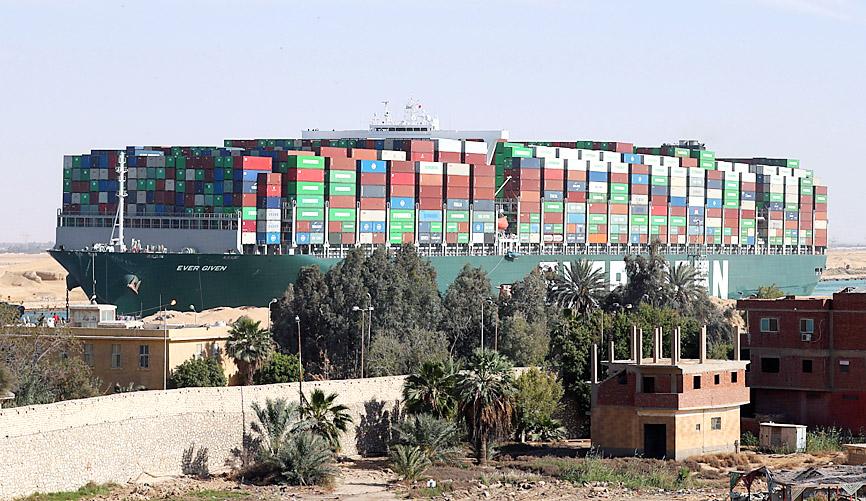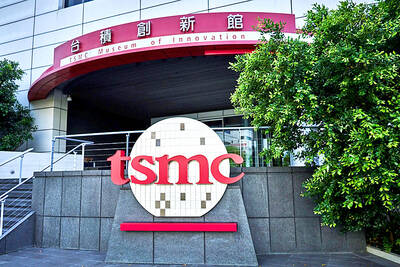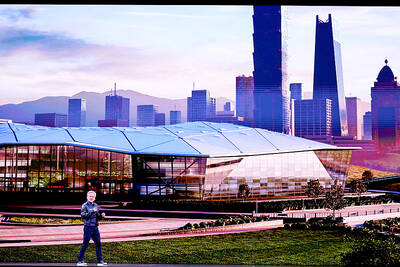If you think the ultimate reason the Suez Canal got blocked last week is because container ships are getting too big, get ready for the future. The next few generations of cargo vessels are going to make the Ever Given look like a bath toy.
Big enough to carry 20,124 twenty-foot equivalent units, or TEUs — the standard measure for cargo, representing a single shipping container — the Ever Given was one of the world’s largest such vessels when it was launched in 2018. The first container ship to break the 20,000-TEU mark had been at sea for less than a year.
One famed 1999 study, written at a time when the largest boats carried fewer than 8,000 TEUs, argued that it would prove impossible to build craft bigger than 18,000 TEUs.

Photo: EPA-EFE
The Ever Given, finally floating on its way again, is now distinctly in the second class of mega-freighters. There are nearly 100 ships carrying more than 20,000 TEUs on the seas or under construction, and the bigger vessels being assembled in Chinese and South Korean shipyards are mostly around the 24,000-TEU mark.
One-quarter of the capacity moved by the world’s largest container line, AP Moller-Maersk A/S, is on boats above the 17,500-TEU mark.
That is unlikely to be the end of it. Chinese shipyard Hudong-Zhonghua Shipbuilding (Group) Co (滬東中華造船) has already registered designs for a 25,000 TEU vessel, and it has become relatively commonplace to predict that 30,000 TEU monsters would be plowing the oceans before the decade is out.
Such enormous hulls might cause problems that would put the Ever Given’s mishap into the shade.
At Rotterdam, the Netherlands, the largest ships already have to arrive at high tide to ensure there is enough clearance for them to get through the channel, according to a 2019 study by Nam Kyu Park of South Korea’s Tongmyong University.
Larger vessels would soon be unable to berth at Shanghai, Busan and Hong Kong even at high tide, unless channels are dredged out further, Park wrote.
There are similar problems with infrastructure on dry land. Modern ports are astonishingly efficient at unloading, and can turn around a fully laden 20,000-TEU vessel in a couple of days.
However, the time spent waiting for a berth can cut deep into the wafer-thin economics of a container line. Longer quays might have to be built to accommodate the larger ships, as well as cranes that can reach across wider decks, larger loading yards for tens of thousands of containers, and faster rail and road terminals to take cargo to its next destination.
Current vessels are already at the limits of what can fit along major shipping lanes. The Ever Given is too bulky to squeeze through the Panama Canal, where boats must be lifted over its mountainous spine with massive lock gates.
At 24m deep, the Suez Canal has more capacity — but it is roughly as deep as the Straits of Malacca and Singapore, so dredging it further to accommodate bigger ships would not help much. The binding constraint on east-west trade at this point is not engineering, but geology.
Extending 15.7m below the water line, the Ever Given should not, on paper, have trouble making it through any of those channels, which typically require 3.5m of clearance from the bottom. Next-generation ships with a 20m draught, on the other hand, would be at constant risk of grounding.
How have container ships managed to defy expectations that their size would hit fundamental limits? A large part of it is because the economies of scale are so compelling. Bigger vessels use more fuel, but relative to the number of boxes stacked on their decks they are far more efficient.
They can also turn around a larger number of containers at a time and serve a wider array of feeder ports, ensuring they can defray their massive capital costs quicker.
There is little sign that this is about to change. New International Maritime Organization (IMO) regulations against the burning of sulfur-intensive fuel oil introduced last year mean current ships are using costlier diesel, putting more pressure on naval architects to come up with yet more efficient designs.
Beyond that, the IMO has plans to reduce carbon dioxide emissions by 40 percent in 2030 compared with 2008, and by 70 percent by 2050. Even with a switch to cheaper, less-polluting liquefied natural gas as the main fuel, that will mean further drastic improvements in efficiency, not to mention propulsion technologies that do not exist yet. To date, the best way to chip away at fuel consumption and emissions is by increasing size.
It is hard to know how the industry is going to cope with this. Perhaps Suez, Malacca and Singapore can be dredged to accommodate even bigger vessels. Perhaps shipyards would find ways to squeeze a few more inches out of existing channels.
If not, alternative routes around the Cape of Good Hope and through the deeper Straits of Sunda and Lombok between Indonesia’s islands might prove the only viable way to accommodate such massive boats.
Should that happen, those economies of scale would have to be drastically larger to make up for the longer sailing time. We have seen container ships leap from 10,000 TEUs to 24,000 TEUs. Do not be shocked to see 50,000 TEU vessels plying the sea in your lifetime.
David Fickling is a Bloomberg Opinion columnist covering commodities, as well as industrial and consumer companies. He has been a reporter for Bloomberg News, Dow Jones, the Wall Street Journal, the Financial Times and the Guardian.
This column does not necessarily reflect the opinion of the editorial board or Bloomberg LP and its owners.

SEEKING CLARITY: Washington should not adopt measures that create uncertainties for ‘existing semiconductor investments,’ TSMC said referring to its US$165 billion in the US Taiwan Semiconductor Manufacturing Co (TSMC, 台積電) told the US that any future tariffs on Taiwanese semiconductors could reduce demand for chips and derail its pledge to increase its investment in Arizona. “New import restrictions could jeopardize current US leadership in the competitive technology industry and create uncertainties for many committed semiconductor capital projects in the US, including TSMC Arizona’s significant investment plan in Phoenix,” the chipmaker wrote in a letter to the US Department of Commerce. TSMC issued the warning in response to a solicitation for comments by the department on a possible tariff on semiconductor imports by US President Donald Trump’s

The government has launched a three-pronged strategy to attract local and international talent, aiming to position Taiwan as a new global hub following Nvidia Corp’s announcement that it has chosen Taipei as the site of its Taiwan headquarters. Nvidia cofounder and CEO Jensen Huang (黃仁勳) on Monday last week announced during his keynote speech at the Computex trade show in Taipei that the Nvidia Constellation, the company’s planned Taiwan headquarters, would be located in the Beitou-Shilin Technology Park (北投士林科技園區) in Taipei. Huang’s decision to establish a base in Taiwan is “primarily due to Taiwan’s talent pool and its strength in the semiconductor

An earnings report from semiconductor giant and artificial intelligence (AI) bellwether Nvidia Corp takes center stage for Wall Street this week, as stocks hit a speed bump of worries over US federal deficits driving up Treasury yields. US equities pulled back last week after a torrid rally, as investors turned their attention to tax and spending legislation poised to swell the US government’s US$36 trillion in debt. Long-dated US Treasury yields rose amid the fiscal worries, with the 30-year yield topping 5 percent and hitting its highest level since late 2023. Stocks were dealt another blow on Friday when US President Donald

UNCERTAINTY: Investors remain worried that trade negotiations with Washington could go poorly, given Trump’s inconsistency on tariffs in his second term, experts said The consumer confidence index this month fell for a ninth consecutive month to its lowest level in 13 months, as global trade uncertainties and tariff risks cloud Taiwan’s economic outlook, a survey released yesterday by National Central University found. The biggest decline came from the timing for stock investments, which plunged 11.82 points to 26.82, underscoring bleak investor confidence, it said. “Although the TAIEX reclaimed the 21,000-point mark after the US and China agreed to bury the hatchet for 90 days, investors remain worried that the situation would turn sour later,” said Dachrahn Wu (吳大任), director of the university’s Research Center for